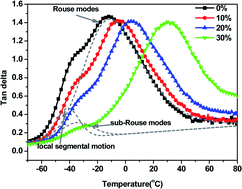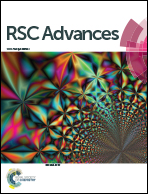The molecular dynamics of different relaxation modes in asymmetric chlorinated butyl rubber/petroleum resin blends
Abstract
The relaxation behavior and different modes of molecular motion in the miscible blends of asymmetric chlorinated butyl rubber (CIIR) and petroleum resin (PR) were investigated by dynamic mechanical spectroscopy (DMS) and dielectric spectroscopy (DS). The different modes of CIIR molecular motion, attributed to local segmental motion, sub-Rouse modes and Rouse mode relaxation, have been detected from both of the DMS and DS results, and the relaxation times of local segmental motion and Rouse modes could be fitted by the Vogel–Fulcher–Tammann equation. Due to the increased activation energy with increasing PR content, local segmental motion of CIIR is slightly confined, however, Rouse modes of CIIR, which contain more backbone bonds and need a larger free volume than the local segmental motion, are greatly confined. As a result, the relaxation temperature of local segmental motion moves slightly to high temperature but that of Rouse modes moves to high temperature more significantly.


 Please wait while we load your content...
Please wait while we load your content...